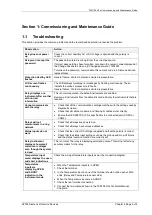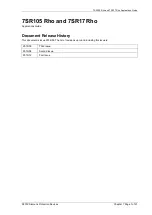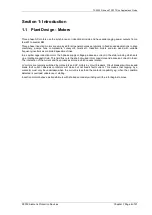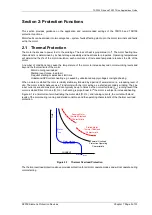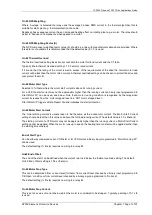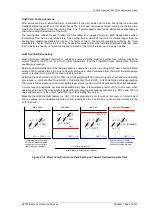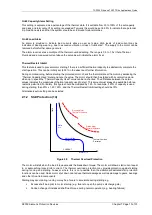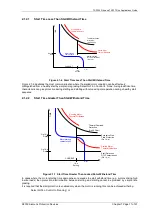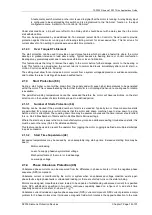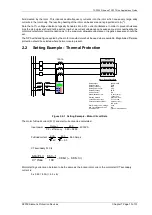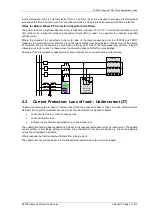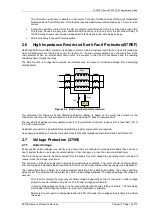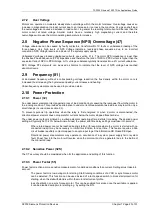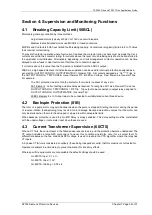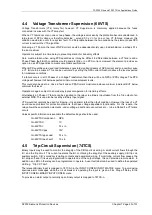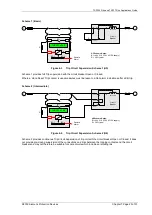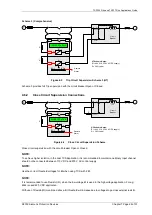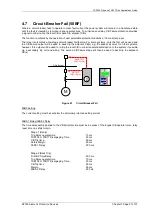
7SR105 Rho and 7SR17 Rho Applications Guide
©2018 Siemens Protection Devices
Chapter 7 Page 12 of 31
A tachometric switch mounted on the rotor is used to signal that the motor is running. A relay binary input
is configured to be energised by this switch and is programmed to the ‘No Accel.’ function in the input
configuration menu. Select Gn14-n Control to ‘No Accel’.
Under stall conditions, a trip will occur after Gn14-n Delay which should be set with a delay less than the motor
stall withstand time.
This can be supplemented by an additional Gn-14-n element (select Gn14-n Control to ‘None’) used to provide
protection against the motor running up but drawing starting current for an excessive time. This timer runs for
current above Gn14-n setting to provide excessive start time protection.
2.1.2.3
Over Torque DTL Element
The stall protection can be used to provide an over-torque feature which provides a faster trip where the motor
develops a gradual increase in load above rating. Typical causes are bearing failure or control malfunction.
Bearings may prematurely wear due to excessive vibration or loss of lubrication.
This feature allows the relay to remove the supply to the motor before further damage occurs to the bearing or
load. This function is primed when the current returns to normal load levels immediately after a motor start i.e.
Gn14-n Control is selected to ‘Running’
The setting must allow for an increase in motor current from a system voltage depression or sudden acceleration
and to allow the relay to distinguish between backfed faults.
2.1.3 Start Protection (66)
During a start higher current will be drawn from the supply and will cause higher temperatures to be generated
within the motor. This is exacerbated by the fact that the motor is not rotating and hence no cooling due to rotation
is available.
The permitted winding temperatures cannot be exceeded therefore the motor will have restrictions on the start
duration or on the number of starts that are allowed in a defined period.
2.1.3.1
Number of Starts Protection (66)
Starting can be blocked if the permitted number of starts is exceeded. Typically two or three consecutive starts
are permitted for a large motor which means that the motor and driven machine have to slow down to a stop
before a start is attempted. The coasting down time may be several minutes and the time interval should reflect
this i.e. Gn 66 Max Number of Starts and Gn 66 Max Starts Period settings.
Where the start duty is severe the motor manufacturer may impose a deliberate waiting time between starts, this
must be set on the relay (Gn 66 Time Between Starts).
This feature can be used to prevent the operator from jogging the motor. Jogging is defined as multiple start/stops
in quick succession.
2.1.3.2
Start Time Supervision (48)
Excessive temperatures may be caused by an unacceptably long start-up time. Excessive starting time may be
due to:
Motor overloading
Loss of a supply phase/unsymmetrical voltage
Mechanical failure of the motor or load bearings
Low supply voltage
2.1.4 Phase Unbalance Protection (46)
Unbalanced phase currents can be measured from the difference in phase currents or from the negative phase
sequence (NPS) component.
Unbalance current is contributed by the motor or system when an unbalanced voltage condition exists (open
phase faults, single phase faults or unbalanced loading) or there are shorted turns on the stator winding
Motors are designed, manufactured and tested to be capable of withstanding unbalanced current for specified
limits. NPS withstand is specified in two parts; continuous capability based on a figure of I
2
, and short time
capability based on a constant, K, where K = (I
2
)
2
t.
Unbalance current includes a negative phase sequence (NPS) current component. NPS current presents a major
problem for 3-phase motors since it produces a magnetic field which rotates in the opposite direction to the main
Summary of Contents for 7SR105 Rho
Page 1: ...Answers for energy 7SR105 Rho User Manual Motor Protection Relay Reyrolle Protection Devices ...
Page 2: ...Siemens Protection Devices 2 ...
Page 95: ...7SR105 Rho Technical Manual Chapter 4 Page 2 of 70 2018 Siemens Protection Devices ...
Page 99: ...7SR105 Rho Technical Manual Chapter 4 Page 6 of 70 2018 Siemens Protection Devices ...
Page 127: ...7SR105 Rho Technical Manual Chapter 4 Page 34 of 70 2018 Siemens Protection Devices ...
Page 153: ...7SR105 Rho Technical Manual Chapter 4 Page 60 of 70 2018 Siemens Protection Devices ...
Page 155: ...7SR105 Rho Technical Manual Chapter 4 Page 62 of 70 2018 Siemens Protection Devices ...
Page 157: ...7SR105 Rho Technical Manual Chapter 4 Page 64 of 70 2018 Siemens Protection Devices ...


